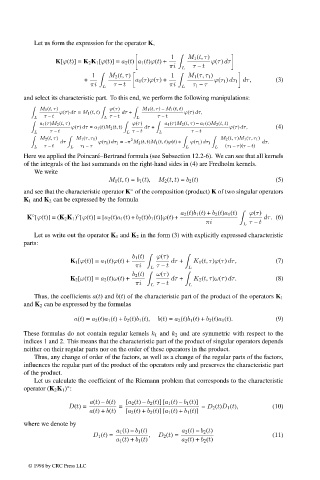Page 666 - Handbook Of Integral Equations
P. 666
Let us form the expression for the operator K,
1 M 1 (t, τ)
K[ϕ(t)] = K 2 K 1 [ϕ(t)] ≡ a 2 (t) a 1 (t)ϕ(t)+ ϕ(τ) dτ
πi L τ – t
1 M 2 (t, τ) 1 M 1 (τ, τ 1 )
+ a 1 (τ)ϕ(τ)+ ϕ(τ 1 ) dτ 1 dτ, (3)
πi L τ – t πi L τ 1 – τ
and select its characteristic part. To this end, we perform the following manipulations:
M 1 (t, τ) ϕ(τ) M 1 (t, τ) – M 1 (t, t)
ϕ(τ) dτ = M 1 (t, t) dτ + ϕ(τ) dτ,
τ – t τ – t
L L τ – t L
a 1 (τ)M 2 (t, τ) ϕ(τ) a 1 (τ)M 2 (t, τ) – a 1 (t)M 2 (t, t)
ϕ(τ) dτ = a 1 (t)M 2 (t, t) dτ + ϕ(τ) dτ, (4)
L τ – t L τ – t L τ – t
M 2 (t, τ) M 1 (τ, τ 1 ) M 2 (t, τ)M 1 (τ, τ 1 )
2
dτ ϕ(τ 1 ) dτ 1 = –π M 2 (t, t)M 1 (t, t)ϕ(t)+ ϕ(τ 1 ) dτ 1 dτ.
L τ – t L τ 1 – τ L L (τ 1 – τ)(τ – t)
Here we applied the Poincar´ e–Bertrand formula (see Subsection 12.2-6). We can see that all kernels
of the integrals of the last summands on the right-hand sides in (4) are Fredholm kernels.
We write
M 1 (t, t)= b 1 (t), M 2 (t, t)= b 2 (t) (5)
and see that the characteristic operator K of the composition (product) K of two singular operators
◦
K 1 and K 2 can be expressed by the formula
a 2 (t)b 1 (t)+ b 2 (t)a 1 (t) ϕ(τ)
◦
◦
K [ϕ(t)]=(K 2 K 1 ) [ϕ(t)] = [a 2 (t)a 1 (t)+ b 2 (t)b 1 (t)]ϕ(t)+ dτ. (6)
πi τ – t
L
Let us write out the operator K 1 and K 2 in the form (3) with explicitly expressed characteristic
parts:
b 1 (t) ϕ(τ)
K 1 [ϕ(t)] ≡ a 1 (t)ϕ(t)+ dτ + K 1 (t, τ)ϕ(τ) dτ, (7)
πi L τ – t L
b 2 (t) ω(τ)
K 2 [ω(t)] ≡ a 2 (t)ω(t)+ dτ + K 2 (t, τ)ω(τ) dτ. (8)
πi L τ – t L
Thus, the coefficients a(t) and b(t) of the characteristic part of the product of the operators K 1
and K 2 can be expressed by the formulas
a(t)= a 2 (t)a 1 (t)+ b 2 (t)b 1 (t), b(t)= a 2 (t)b 1 (t)+ b 2 (t)a 1 (t). (9)
These formulas do not contain regular kernels k 1 and k 2 and are symmetric with respect to the
indices 1 and 2. This means that the characteristic part of the product of singular operators depends
neither on their regular parts nor on the order of these operators in the product.
Thus, any change of order of the factors, as well as a change of the regular parts of the factors,
influences the regular part of the product of the operators only and preserves the characteristic part
of the product.
Let us calculate the coefficient of the Riemann problem that corresponds to the characteristic
operator (K 2 K 1 ) :
◦
a(t) – b(t) [a 2 (t) – b 2 (t)] [a 1 (t) – b 1 (t)]
D(t)= = = D 2 (t)D 1 (t), (10)
a(t)+ b(t) [a 2 (t)+ b 2 (t)] [a 1 (t)+ b 1 (t)]
where we denote by
a 1 (t) – b 1 (t) a 2 (t) – b 2 (t)
D 1 (t)= , D 2 (t)= (11)
a 1 (t)+ b 1 (t) a 2 (t)+ b 2 (t)
© 1998 by CRC Press LLC
© 1998 by CRC Press LLC
Page 649

